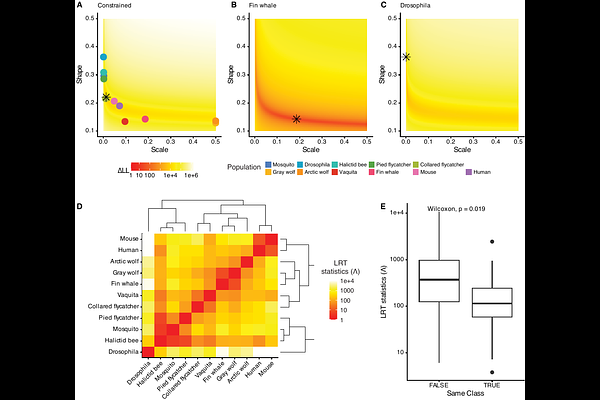The distribution of fitness effects varies phylogenetically across animals

The distribution of fitness effects varies phylogenetically across animals
Lin, M.; Chakraborty, S.; Amorim, C. E. G.; Morales, S. N.; Beichman, A. C.; Nunez-Valencia, P. G.; Mah, J. C.; Ronbinson, J. A.; Kyriazis, C. C.; Huber, C. D.; Webb, A. E.; Kocher, S. D.; Archer, F. I.; Moreno-Estrada, A.; Wayne, R. K.; Lohmueller, K. E.
AbstractThe distribution of fitness effects (DFE) describes the selection coefficients (s) of newly arising mutations and fundamentally influences population genetic processes. However, the extent and mechanisms of DFE variation have not been systematically investigated across species with divergent phylogenetic histories and ecological functions. Here, we inferred the DFE in natural populations of eleven animal (sub)species, including humans, mice, fin whales, vaquitas, wolves, collared flycatchers, pied flycatchers, halictid bees, drosophila, and mosquitoes. We find that the DFE co-varies with phylogeny, where the expected mutation effects are more similar in closely related species (Pagel\'s {lambda} = 0.84, P = 0.01). Additionally, mammals have a higher proportion of strongly deleterious mutations (22% to 47% in mammals; 0.0% to 5.4% in insects and birds) and a lower proportion of weakly deleterious mutations than insects and birds. Population size is significantly negatively correlated with the expected impact of new deleterious mutations (PGLS{lambda}, P = 0.03), and the proportion of new beneficial mutations (r2 = 0.73, P < 0.001). These findings align with Fisher\'s Geometric Model (FGM), which defines organismal complexity as the number of phenotypes under selection. Consistent with the FGM\'s predictions, we observe that mutations are more deleterious in complex organisms, while beneficial mutations occur more frequently in smaller populations to compensate for the drift load. Our study demonstrates strong phylogenetic constraints in the evolution of a fundamental population genetics parameter, and proposes that, through mechanisms of global epistasis, long-term population size and organismal complexity drive variation in the DFE across animals.